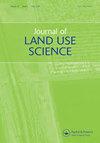Spatial planning zoning based on land-type mapping: a case study in Changzhou City, Eastern China
IF 3.3
4区 环境科学与生态学
Q1 AGRICULTURE, MULTIDISCIPLINARY
引用次数: 1
Abstract
ABSTRACT In China, land-use policy-making relies on spatial planning zoning based on land suitability assessments. Given the complexity of land resources, there is no universally agreed suitability assessment index system. Land-type research, which aims to map interactions among environmental components (e.g. landform, soil type, and land cover, etc.) can identify units with certain homogeneity of land characteristics, providing a unified framework for land suitability assessments. Combining multi-source data and geospatial analysis methods, we identified the agricultural land quality and urban functional areas as proxies for land-use intensities, and proposed a 1:100,000 hierarchical classification system, which integrated landform, soil type, land-use type, and land-use intensity. The land in Changzhou City was classified into 3 classes, 37 subclasses, and 137 land units. Comprehensive knowledge about the characteristics of land units further generated a qualitative land suitability analysis and village-scale spatial planning zones based on expert knowledge without an auxiliary suitability assessment index system.基于土地类型图的空间规划区划——以常州市为例
摘要在中国,土地利用决策依赖于基于土地适宜性评估的空间规划区划。鉴于土地资源的复杂性,目前还没有一个公认的适宜性评估指标体系。土地类型研究旨在绘制环境组成部分(如地形、土壤类型和土地覆盖等)之间的相互作用图,可以识别具有一定同质性的土地特征单元,为土地适宜性评估提供统一的框架。结合多源数据和地理空间分析方法,我们确定了农业用地质量和城市功能区作为土地利用强度的指标,并提出了一个1:100000的分级分类系统,该系统综合了地形、土壤类型、土地利用类型和土地利用强度。将常州市土地划分为3类,37个亚类,137个土地单元。对土地单元特征的综合了解,在没有辅助适宜性评估指标体系的情况下,基于专家知识,进一步生成了定性的土地适宜性分析和村庄尺度空间规划区。
本文章由计算机程序翻译,如有差异,请以英文原文为准。
求助全文
约1分钟内获得全文
求助全文
来源期刊

Journal of Land Use Science
Environmental Science-Management, Monitoring, Policy and Law
CiteScore
5.40
自引率
6.20%
发文量
26
期刊介绍:
The Journal of Land Use Science provides a central outlet for high-quality articles on theoretical and empirical aspects of land-use science at the interface of social and environmental systems. The Journal brings together an array of research perspectives at multiple temporal, spatial and social scales that contribute a better understanding of land-system dynamics and communicate scientific advances towards attaining land-system sustainability.
 求助内容:
求助内容: 应助结果提醒方式:
应助结果提醒方式:


